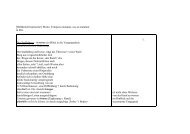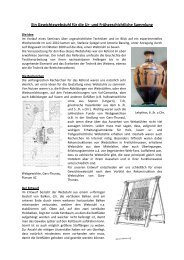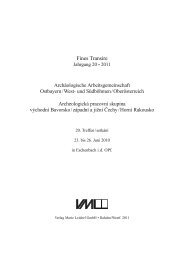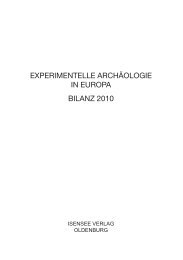Thorsten Uthmeier & Jürgen Richter
Thorsten Uthmeier & Jürgen Richter
Thorsten Uthmeier & Jürgen Richter
Create successful ePaper yourself
Turn your PDF publications into a flip-book with our unique Google optimized e-Paper software.
Chapter 14<br />
Transformation Analysis at Kabazi II, Levels VI/11-14<br />
Fig. 14-4 Kabazi II, Level VI/11: Shapes of nodules. Fig. 14-5 Kabazi II, Level VI/11: Nature of raw materials.<br />
S����� ��� ��� N��� F�����:<br />
T������������� A������� �� L���� VI/12<br />
Finds from this level were made in the north-western<br />
corner of the excavated area (Fig.14-7). Raw<br />
material supply seems to have been random, with<br />
both round and flat nodules (Fig.14-8) and mainly<br />
residual sources (Fig. 14-9). Raw material units<br />
are quite small, comprising less than 10 artefacts.<br />
Only RMU 1 contains as many as 25 artefacts (Fig.<br />
14-10). The la�er displays a complete transformational<br />
sequence (Nm/f; Fig.14-11 and 14-12): A<br />
raw nodule was brought in and broken into large<br />
chunks. Two of these were discarded, and a further<br />
three were transformed into preforms for foliates.<br />
One preform underwent initial surface shaping<br />
only and was soon discarded. The remaining<br />
two were transformed into narrow, triangular leaf<br />
points, one of which was discarded as a whole a�er<br />
intensive use. The second of the points remained<br />
on the site, a�er medial fracture, as a basal fragment,<br />
the distal fragment having been exported.<br />
Leaf points were obviously designed for on-site<br />
use. Generally, there are three groups of operational<br />
chains (Fig. 14-13). Firstly, importation and<br />
discard of blanks (RMU 10, RMU 11). Secondly,<br />
importation of preforms, initial core-like exploita-<br />
tion (few blanks are produced from surface shaping<br />
to be used and discarded on-site), and export<br />
of the same preforms (RMU 5, RMU 6, RMU 7,<br />
perhaps also RMU 4). Thirdly, importation of raw<br />
nodules, production and export of preforms. The<br />
operational chains are short and do not result in<br />
the production of completed leaf points as, for example,<br />
in level VI/6.<br />
The second group (core-like pieces) repeats<br />
an observation made previously at other interglacial<br />
levels of Kabazi II. Preforms served not only<br />
as blanks for foliate pieces, but also as a source<br />
of some limited flake production. Thus, preforms<br />
were not entirely shaped at one time, but shaping<br />
was dispersed over a certain time range and was<br />
only carried out when flakes were needed. Only<br />
then were they transformed into leaf points. In<br />
this level, preforms replace cores. Were concepts<br />
for flake production unknown at this time?<br />
To summarize, level VI/12 has extremely<br />
short operational sequences. The Kabazi II site<br />
must have been a short stop within a circulating<br />
se�lement pa�ern. Production for export is very<br />
limited (RMU 1, RMU 10, RMU 11 only).<br />
231







